Alexei Leonov, the world’s first spacewalker, dies
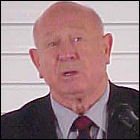 Cosmonaut Alexei Leonov, the first human being to perform extravehicular activity (or, as it has become more commonly known, a spacewalk) outside his spacecraft, dies at the age of 85. He was among the 20 Soviet Air Force pilots selected to undergo cosmonaut training in 1960, and undertook the historic first spacewalk on March 18th, 1965, aboard the Voskhod 2 mission. He remained outside the vehicle for twelve minutes, but due to his spacesuit inflating with the pressure of his breathing oxygen, he had severe difficulty climbing back into the tunnel that extended from the vehicle itself for his exit, leading mission controllers in Russia to consider the possibility that he might perish without being able to climb back in. He was able to re-enter the Voskhod capsule with considerable effort, and became a favorite among Soviet-era mission planners for the honor of being the first cosmonaut to set foot on the moon, but crewed Soviet lunar missions never came to fruition as the Apollo moon shots took the lead in the space race. Leonov was later selected to lead the Soyuz 19 mission, the Soviet half of the Apollo-Soyuz Test Project, in 1975. He was also an avid artist who drew and painted many of his own space experiences, as well as those related to him by other astronauts and cosmonauts.
Cosmonaut Alexei Leonov, the first human being to perform extravehicular activity (or, as it has become more commonly known, a spacewalk) outside his spacecraft, dies at the age of 85. He was among the 20 Soviet Air Force pilots selected to undergo cosmonaut training in 1960, and undertook the historic first spacewalk on March 18th, 1965, aboard the Voskhod 2 mission. He remained outside the vehicle for twelve minutes, but due to his spacesuit inflating with the pressure of his breathing oxygen, he had severe difficulty climbing back into the tunnel that extended from the vehicle itself for his exit, leading mission controllers in Russia to consider the possibility that he might perish without being able to climb back in. He was able to re-enter the Voskhod capsule with considerable effort, and became a favorite among Soviet-era mission planners for the honor of being the first cosmonaut to set foot on the moon, but crewed Soviet lunar missions never came to fruition as the Apollo moon shots took the lead in the space race. Leonov was later selected to lead the Soyuz 19 mission, the Soviet half of the Apollo-Soyuz Test Project, in 1975. He was also an avid artist who drew and painted many of his own space experiences, as well as those related to him by other astronauts and cosmonauts.
Apollo-Soyuz Crew Reunion
 The surviving Apollo-Soyuz Test Project astronauts and cosmonauts gather at the Stafford Air & Space Museum (founded by Apollo-Soyuz commander Thomas Stafford) in Weatherford, Oklahoma to mark the 30th anniversary of the first international manned spaceflight. (theLogBook.com’s webmaster is in attendance.)
The surviving Apollo-Soyuz Test Project astronauts and cosmonauts gather at the Stafford Air & Space Museum (founded by Apollo-Soyuz commander Thomas Stafford) in Weatherford, Oklahoma to mark the 30th anniversary of the first international manned spaceflight. (theLogBook.com’s webmaster is in attendance.)
We Have Capture: Tom Stafford and the Space Race
 Smithsonian Books publishes General Thomas Stafford’s non-fictional memoir of his time in NASA, “We Have Capture: Tom Stafford and the Space Race“, co-written with Michael Cassutt. The book details Stafford’s involvement in several NASA missions, from the Gemini program through the high-profile flights of Apollo 10 to the moon and the international Apollo-Soyuz Test Project mission.
Smithsonian Books publishes General Thomas Stafford’s non-fictional memoir of his time in NASA, “We Have Capture: Tom Stafford and the Space Race“, co-written with Michael Cassutt. The book details Stafford’s involvement in several NASA missions, from the Gemini program through the high-profile flights of Apollo 10 to the moon and the international Apollo-Soyuz Test Project mission.
Deke! U.S. Manned Space From Mercury to the Shuttle
 Forge Books posthumously publishes astronaut Deke Slayton’s non-fictional memoir of his time in NASA, “Deke! U.S. Manned Space From Mercury to the Shuttle“, co-written with Michael Cassutt. The book details Slayton’s selection to the Mercury ground and his subsequent medical grounding, his time in charge of NASA’s astronaut office, and his eventual flight aboard the international Apollo-Soyuz Test Project mission.
Forge Books posthumously publishes astronaut Deke Slayton’s non-fictional memoir of his time in NASA, “Deke! U.S. Manned Space From Mercury to the Shuttle“, co-written with Michael Cassutt. The book details Slayton’s selection to the Mercury ground and his subsequent medical grounding, his time in charge of NASA’s astronaut office, and his eventual flight aboard the international Apollo-Soyuz Test Project mission.
Space Cooperation Agreement renewed
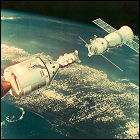 With the 1972 agreement having resulted in the successful Apollo-Soyuz Test Project, the United States and the Soviet Union formally renew the Space Cooperation Agreement. As an immediate goal to build on Apollo-Soyuz, both countries hold tentative discussions about docking the American Space Shuttle (which, it is still assumed, will be in space before the 1970s are out) and a Soviet Salyut space station. Though the shuttle’s first flight is still being delayed, the biggest hurdle will prove to be international relations, specifically a renewed chilling of the Cold War thanks to the Soviet Union’s 1979 invasion of Afghanistan.
With the 1972 agreement having resulted in the successful Apollo-Soyuz Test Project, the United States and the Soviet Union formally renew the Space Cooperation Agreement. As an immediate goal to build on Apollo-Soyuz, both countries hold tentative discussions about docking the American Space Shuttle (which, it is still assumed, will be in space before the 1970s are out) and a Soviet Salyut space station. Though the shuttle’s first flight is still being delayed, the biggest hurdle will prove to be international relations, specifically a renewed chilling of the Cold War thanks to the Soviet Union’s 1979 invasion of Afghanistan.
Apollo’s final descent danger
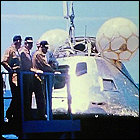 The “age of Apollo” comes to an unbreathable end in an incident during the return of the final Apollo spacecraft. Returning from their successful Apollo-Soyuz Test Project flight, astronauts Thomas Stafford, Deke Slayton and Vance Brand are exposed to fumes from their vehicle’s own reaction control thrusters, thanks to the thrusters firing after the capsule’s air vents open during descent toward the Pacific Ocean. Brand reportedly passes out momentarily due to the toxic fumes. All three astronauts are hospitalized for two weeks in Hawaii.
The “age of Apollo” comes to an unbreathable end in an incident during the return of the final Apollo spacecraft. Returning from their successful Apollo-Soyuz Test Project flight, astronauts Thomas Stafford, Deke Slayton and Vance Brand are exposed to fumes from their vehicle’s own reaction control thrusters, thanks to the thrusters firing after the capsule’s air vents open during descent toward the Pacific Ocean. Brand reportedly passes out momentarily due to the toxic fumes. All three astronauts are hospitalized for two weeks in Hawaii.
Apollo-Soyuz: thawing the Cold War in orbit
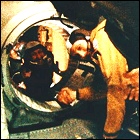 The last Apollo spacecraft to fly makes history by docking with a Soviet-launched Soyuz spacecraft in orbit, allowing the crews to visit each other and conduct joint scientific experiments. The first docking of the Apollo-Soyuz Test Project is hailed as a major development in international relations as well as spaceflight, though it will be 20 years before the feat is repeated. Plans for a second Apollo-Soyuz flight the following year are scuttled due to budget concerns, and the need to commence work on converting NASA’s launch facilities for future shuttle launches rather than further Apollo launches.
The last Apollo spacecraft to fly makes history by docking with a Soviet-launched Soyuz spacecraft in orbit, allowing the crews to visit each other and conduct joint scientific experiments. The first docking of the Apollo-Soyuz Test Project is hailed as a major development in international relations as well as spaceflight, though it will be 20 years before the feat is repeated. Plans for a second Apollo-Soyuz flight the following year are scuttled due to budget concerns, and the need to commence work on converting NASA’s launch facilities for future shuttle launches rather than further Apollo launches.
Apollo-Soyuz and Soyuz 19
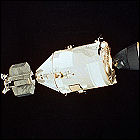 The final launch of an Apollo spacecraft takes place as the last Saturn rocket carries the American component of the Apollo-Soyuz Test Project into orbit. A cooperative international mission intended to see the Apollo capsule dock with a Soviet-launched Soyuz, the ASTP will be the last Apollo flight as the push toward the reusable Space Shuttle takes over NASA’s resources and planning. Aboard the Apollo command/service module are Commander Thomas Stafford, command module pilot Vance Brand, and docking module pilot Deke Slayton, the last of the seven original Mercury astronauts to reach space (heart conditions have prevented him from taking part in a mission until now). Soyuz 19, carrying cosmonauts Alexei Leonov and Valery Kubasov, lifts off a few hours earlier.
The final launch of an Apollo spacecraft takes place as the last Saturn rocket carries the American component of the Apollo-Soyuz Test Project into orbit. A cooperative international mission intended to see the Apollo capsule dock with a Soviet-launched Soyuz, the ASTP will be the last Apollo flight as the push toward the reusable Space Shuttle takes over NASA’s resources and planning. Aboard the Apollo command/service module are Commander Thomas Stafford, command module pilot Vance Brand, and docking module pilot Deke Slayton, the last of the seven original Mercury astronauts to reach space (heart conditions have prevented him from taking part in a mission until now). Soyuz 19, carrying cosmonauts Alexei Leonov and Valery Kubasov, lifts off a few hours earlier.
An international space station?
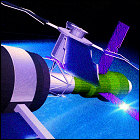 With planning already well underway for the Apollo-Soyuz mission which won’t take place until 1975, NASA commissions a study from McDonnell Douglas to explore the feasibility of a follow-up to the international space mission, possibly involving joining the backup of the Skylab space station (known as “Skylab B”) and a yet-to-be-launched Soviet Salyut space station at some point in the latter half of the 1970s, effectively creating a joint international space station. Although the study goes so far as to specify issues of concern regarding the structure of the two stations and their respective standard atmospheric pressures, the recommendations are shelved pending the outcome of the Apollo-Soyuz flight. Significant political developments in the late 1970s will prevent the idea of an international station from moving forward for at least a quarter century.
With planning already well underway for the Apollo-Soyuz mission which won’t take place until 1975, NASA commissions a study from McDonnell Douglas to explore the feasibility of a follow-up to the international space mission, possibly involving joining the backup of the Skylab space station (known as “Skylab B”) and a yet-to-be-launched Soviet Salyut space station at some point in the latter half of the 1970s, effectively creating a joint international space station. Although the study goes so far as to specify issues of concern regarding the structure of the two stations and their respective standard atmospheric pressures, the recommendations are shelved pending the outcome of the Apollo-Soyuz flight. Significant political developments in the late 1970s will prevent the idea of an international station from moving forward for at least a quarter century.
Apollo-Soyuz agreement signed
 After two years of hammering out details and wording, President Nixon and Soviet Premier Alexei Kosygin sign an international agreement to share science and technology between the United States and Soviet Union, including an agreement to mount a joint space mission culminating in the docking of an Apollo spacecraft and a Soyuz spacecraft in Earth orbit in 1975. Both nations’ space agencies begin crew selection and technical preparations for a joint venture that seemed impossible during the Cold War-fueled race to the moon.
After two years of hammering out details and wording, President Nixon and Soviet Premier Alexei Kosygin sign an international agreement to share science and technology between the United States and Soviet Union, including an agreement to mount a joint space mission culminating in the docking of an Apollo spacecraft and a Soyuz spacecraft in Earth orbit in 1975. Both nations’ space agencies begin crew selection and technical preparations for a joint venture that seemed impossible during the Cold War-fueled race to the moon.